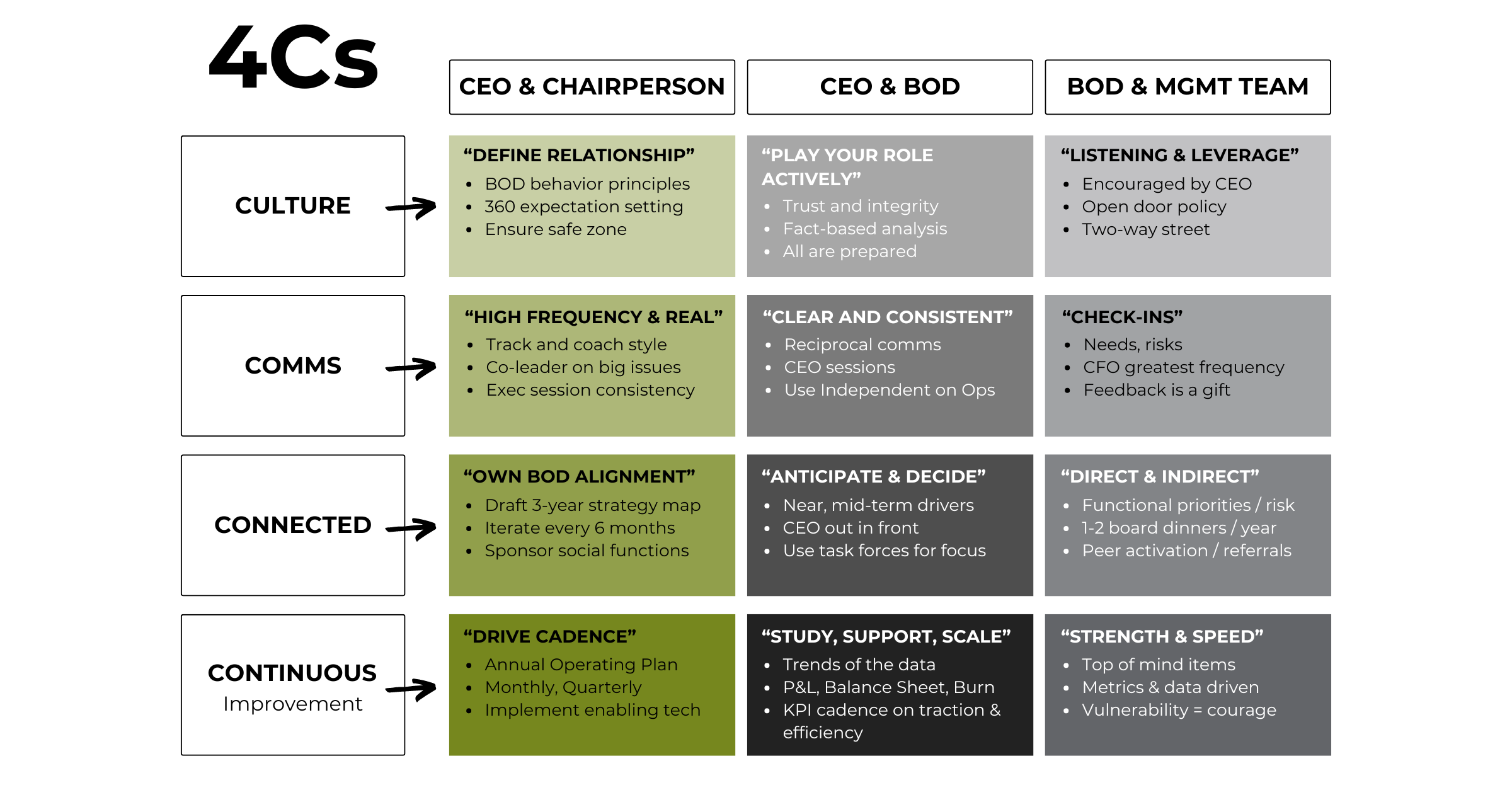Growth-stage companies require more than a capable CEO and executive leadership team to successfully scale growth. Seasoned board directors with relevant skills and expertise are also a critical ingredient for taking a business to the next level – but effective boards are not built overnight. To ensure a board’s ongoing success and alignment—between the CEO and chairperson, the CEO and the board, and the board and the management team—it’s essential to focus on some core fundamentals. We call these the Four Cs: Culture, Communication, Connectedness, and Continuous Improvement.

General Partner Gregg Michaelson touched on the Four Cs in this blog from 2021, and the principles remain just as, if not more important today. Each of these characteristics is crucial to creating and sustaining a high-impact board:
Culture is the combination of relationships, styles, and behaviors that exist on the board. When culture is strong, the CEO has a strong relationship with the board chair and works together with him or her to get the greatest value possible out of all board interactions. Board members give and receive trust and feel psychologically safe enough to openly share feedback and ideas with the CEO and each other. The management team is encouraged to engage with the board and feels empowered to leverage board members’ expertise to drive the business forward. Other indicators of a positive board culture include:
- Board meetings are open and safe zones for ideas and critical feedback for and from the CEO
- The CEO feels free to highlight emergent problems or issues in full board presence or sidebars
- There is 100% attendance at all board meetings
- Directors prepare and ask relevant questions succinctly
If you are looking to improve your board’s culture, consider pursuing a better understanding of each board member’s personality, work, and communication style. (Assessments like the Hogan are a good place to start.) This baseline knowledge can help board members operate with more empathy and thus establish a work culture of greater harmony.
Communication includes the process and cadence of information sharing and interaction. An effective board depends on open and frequent communication between all parties. This allows the board to work proactively and respond in real-time to any pressing business issues. In boards that prioritize effective communication, the CEO and chairperson speak frequently outside of quarterly meetings and work hand in hand on major issues. The board interacts clearly and consistently with the CEO, with both parties communicating on a reciprocal basis. The management team — particularly the CFO — engages regularly with the board and embraces members’ feedback. To promote a highly communicative board:
- The Chairperson and CEO should ask the board, two weeks before each quarterly meeting, for any agenda requests
- The board needs to talk frequently among themselves between meetings
- Board decks should be distributed to directors three to five days before each meeting
- There should be a system for logging key actions and follow-ups, and distributing the list the following day
- Notes taken during each Executive Session should be shared with the CEO to reinforce feedback
Remember that the standard cadence of one board meeting per quarter is likely not enough to leverage the full power of the board. Regular check-ins between scheduled meetings can help keep everyone informed and aligned.
Connectedness is the vision and strategy for the company and how that plays out in annual and long-term plans. In other words, boards are most effective when they keep the overarching vision for the company in mind and work with company leadership to ensure the right steps are being taken towards that end goal. In a well-connected board, the CEO works with the chairperson to iterate on and communicate long-term strategy plans. The CEO works with the greater board to identify the drivers of success. The board works with the management team to lock in on functional priorities and mitigate risks. Other characteristics of a well-connected board include:
- The long-term vision is connected to the annual plan
- Compensation plans for the executives and organization tie to performance
- A customer and/or market analyst presents to the board 1-2 times per year
- The CEO or management team has at least one project to work on with the board every six to nine months
- Board members offer insights during a company all-hands meeting at least once per year
If connectedness is an issue on your board, consider reiterating the long-term vision on a more regular basis. Challenge board members to connect insights or recommendations to the overarching plan.
Finally, Continuous Improvement refers to the tracking and accountability throughout the entire process that transforms goals into results. The company must hold itself accountable to the board to ensure that planning and goal setting has a measurable impact on the business. This means ensuring board visibility into KPIs and other metrics that offer insight into how the company is doing. To foster continuous improvement, the CEO and board chair must work together on the annual operating plan and establish a regular reporting cadence to share out with the broader board. The management team must also remain data-driven and ensure thorough documentation for enhanced visibility.
For a board to be truly effective, it must first be built on the right foundations. While no two boards are the same, the Four Cs highlight characteristics that all effective boards share – characteristics that ultimately enable the board to deliver the most value possible to growth-stage companies.

.png)
.png)